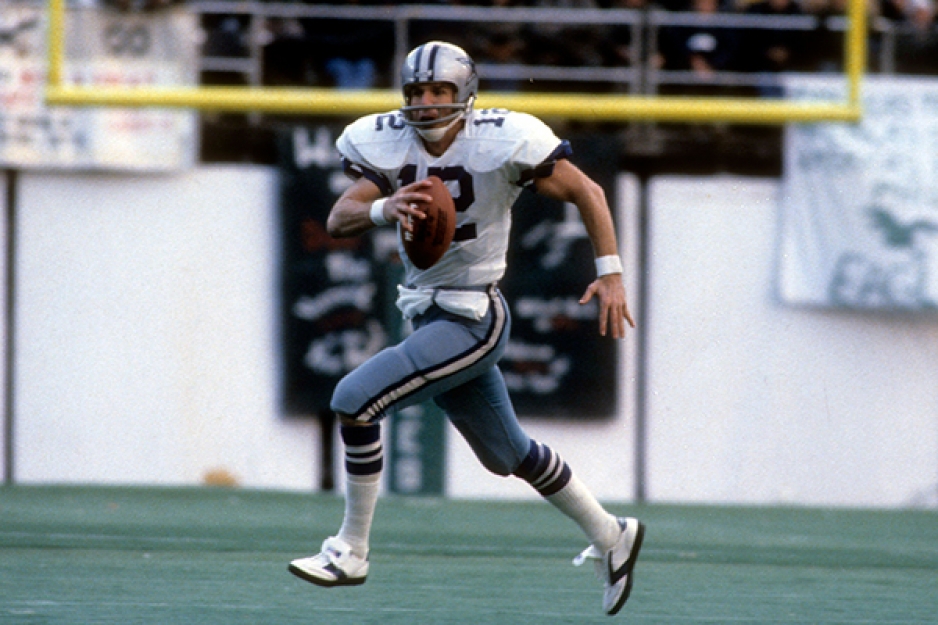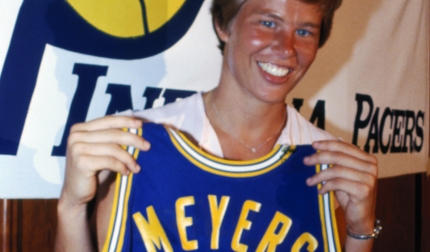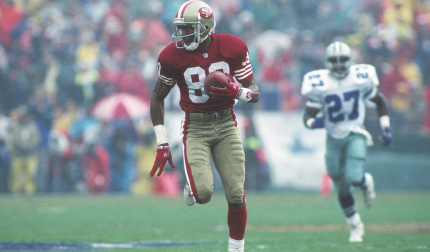How did your time in the Navy help make you who you are?
A big part of the foundation of my life still goes back to being an only child. My mom and dad were great people; they were hard workers. They didn’t have a whole lot, but we had plenty as a family. The Naval Academy taught me more teamwork, discipline, perseverance as far as being resilient and the things that are important to you in life. I also learned the importance of trust and relying on each other and making decisions that might benefit you, but try to understand how they’d affect somebody else. And actually, Coach [Tom] Landry, when I was a rookie at 27 after the Navy, Don Meredith retired, and instead of going after another veteran quarterback—Craig Morton was our only veteran quarterback then—I was looked at on the depth chart as the backup quarterback. Landry really felt rookies take three years to be effective, but he said Roger is more mature by being in the Navy, so I was able to hang in there as a backup quarterback because of my leadership experience in the Navy.
You were, at the time, that rare Heisman winner who wasn’t a senior, winning in your junior year. I have to imagine the hoopla wasn’t nearly what it is now?
No. We had a really good team, though I wasn’t thinking Heisman at all, but as the year went on we beat some good teams. We ended up 9-1. We were the No. 2 team in the country and lost in the Cotton Bowl to Texas who was 10-0. Later on, we had a special meeting in our locker room, and we didn’t know what it was about. Coach [Wayne] Hardin said, “I just want to announce that Roger’s won the Heisman.” So I told everybody, hey, you guys won this Heisman; I’m gonna give you a piece of it. So they’re still asking for a piece of it.
This whole aspect of teammates, it worked for you in football and has certainly translated for you in business.
In sports, there are the ‘what’s in it for me’ people, and they can be effective and win but they’re not going to be your leaders. You’ve got to get a balance of give and take in life, in business, and in football. You want the kind of people on your team that are like the wide receivers who can make the block downfield without getting a bonus for it. It’s not a statistic, but they’re going to do it for the team. In business, you have to get people that want to be successful and want to achieve because that’s who they are, but also want to do it understanding how it affects someone else. Business does have a lot of transferable qualities that are in sports. You still have to pay the price to get there, and I was fortunate to be motivated to work in the offseason. If I were a rookie at 23, I probably would have just goofed around in the offseason like everybody else. But I was forced to think about tomorrow.
Can you talk a bit about that game in 1971 against Chicago when you and Craig Morton alternated at quarterback every play?
That whole 1971 season changed my life. I got a chance to compete with Craig in the preseason; we both played well. Then Coach Landry announced we have two starting quarterbacks. [After six regular season games where each of us started games] we had a divided team. And Craig was a good guy. We got along under the circumstances. Now we’re getting ready to play the Bears in the seventh game, we had a team meeting and Coach Landry gets up there and says, “Hey, we’re gonna alternate quarterbacks on each play.” And Craig and I looked at each other and said, “Man, did coach have a stroke or something?”
There’s not a better football coach than Tom Landry, but sometimes on the field, Landry didn’t know you needed to have somebody in charge out there in the field on offense, and we had a divided team. Then Coach Landry polled the coaches and I got the vote to be the starting quarterback. And it changed my life. He could have gone the other way. But he polled the coaches, I know for a fact they voted for me to be the starting quarterback. We would have won with Craig, too. But it didn’t happen that way.
Tom Landry once said he never designed running plays for you; you did that enough on your own.
When I was playing, he had a lot of respect for me being a leader on the team. He put up with my running, as it wasn’t his stereotype of a quarterback. Coach Landry was very goal-oriented. He was an engineer; he had goals that were outstanding, reasonable, believable, achievable, and they were measured. When I ran, he just felt that wasn’t as effective—but then he realized, these guys on defense, even though they said we hope Staubach runs, they just hated me to run. There weren’t a lot of quarterbacks that ran back then. Fran Tarkenton was more of a scrambler, but I ran for first downs. I felt if I could get the first down, it would keep the ball going, so he put up with it. Even in my last year, we were watching film, and he said, “Someday you’re gonna learn.” I said, “Coach, it’s 11 years, I’ll probably be retiring pretty soon.” He laughed.
You have had enormous success, starting The Staubach Company in 1977, two years before you retired, and now you’re executive chairman of JLL. How has being “America’s Quarterback” helped you in terms of your business career?
When I worked for a real estate firm during the offseasons, part of it is good news/bad news. Being on the Dallas Cowboys, I could get the meetings, but I realized they weren’t necessarily going to hire me if they looked at me as a football player. When I retired, I had started my own company then, and I think it really was a help that they knew I was committed to real estate. But they also knew I enjoyed talking football….there are things that are transferable: the hard work—it takes a lot of unspectacular preparation to get spectacular results. I always believed that, and I always had confidence in the fourth quarter, because I felt I worked really hard and I’m going to do the best I can. If you do that, hopefully good things will happen. You learn a lot in football about hard work and teamwork, perseverance and being resilient, so there’s a lot of qualities as an athlete that are transferable as long as you devote the time and energy to that profession also.
You won two Super Bowls by a combined score of 51-13.
In the first one, we beat Miami. Dallas had the reputation that they couldn’t win the big game. I was still in Navy when they were losing to Green Bay so winning the first one, we were scared the whole way, but finally toward the end, we had a good lead, I mean, Coach Landry—that was probably the most excited he’s ever been. He was being carried off the field, and Walt Garrison was one of the guys carrying him. They asked Walt once, “Have you ever seen Coach Landry smile?” And he said, “No, but I’ve only been here nine years.” But there’s a picture with Walt carrying him off the field, and Coach Landry had the biggest smile on his face. The second time we really outplayed Denver, and we did everything right in that game. Both games, we just didn’t make any mistakes. We didn’t turn the ball over, and those were good games. Against the Steelers, we were just playing a better team.
Yes—you lost two Super Bowls to the Steelers by a combined total of eight points.
When we got to that first Super Bowl, we were playing arguably the best NFL team ever. The Steelers stayed together, and we just had a whole transition of a different team. So I think we outplayed ourselves in that game. We made a few mistakes and had a hard time running the ball. Pittsburgh had these great players—Terry Bradshaw and Lynn Swann were fantastic. The second time though, we had Tony Dorsett, Tony Hill, Butch Johnson, we were really, I think, on an equal footing. They beat us, and it was a tough loss. But they were a great team. If we’d lost and gotten killed by the Steelers, it would have been terrible, but we lost to arguably one of the greatest teams ever. At the end of the day, we lost to a great team.
You had 20 concussions in your career and six that you say knocked you out.
Well, they say 20. I was knocked out once in high school and college. I was knocked out completely six times with the Cowboys. Even in the last game I played in, it was a factor in my retirement when Jack Reynolds hit me. I threw a pass that put us ahead and Reynolds hit me and drove me into the ground. I was screwed up. I didn’t get knocked out totally, but that year I had two concussions—one by LC Greenwood and another one. I had a CAT scan afterwards and the doctor said, “Roger, you’ve had too many concussions and you’re gonna have more of these dings that are really more serious than you think they are.” I think if we’d won that game, and I didn’t get screwed up there at the end, which I think helped cause us to lose, I might have stayed another two years.
You had a great connection with receivers. Can you talk about what you, Drew Pearson and Bob Hayes created together?
Bob Hayes and I played in the college all-star game together. Then I had four years in the Navy, and Bob Hayes was really lighting it up with Don Meredith. I had some really good years with him. One of the best plays I’ve ever been a part of was when we were playing in Yankee Stadium. I threw a pass to Bob Hayes, we were on the five yard line and he caught it at about the 50, and he was like a jet that took off. Spider Lockhart was right on him, and then he was eight yards behind him when Bob crossed the goal line. Bob was special. Drew came in ‘73 and the Hail Mary pass in ‘75 pass was the catch he made. Drew was a free agent, and we worked in the off-season together. He really didn’t have chance of making the team, if you looked at the veterans we had coming back that year. But there was just something special about him, and when we got to training camp, I knew he had a lot of ability. He made team in ’73, and we had some great moments together. He was a very clutch receiver. There’s a chemistry that gets developed between a quarterback and receivers that’s important. You know what they’re going to do and that they’re not going to disappoint you. It’s good to have that kind of feeling and trust in each other.
The Hail Mary play—What is the most interesting legacy of that play for you?
I got knocked down after I threw it, and Drew Pearson made a great catch on his hip and we won. And I was in the locker room and the press said, what were you thinking about, Roger, when you threw it, and I said I closed my eyes and said a Hail Mary. And the Associated Press guy picked it up around the country it was, ‘Hail Mary Pass Wins Game.’ And it just took off. Even Norman Schwarzkopf, when he was going over to the Persian Gulf said, “We might need a Hail Mary over there.” It started to be used in different connotations. We were in three Super Bowls in four years because of that play. I think the Hail Mary beating the Vikings gave us the momentum we had in the late ‘70s.
You have some things in common with Tony Romo: You were drafted in the 10th round and he was undrafted. You’re both scramblers. What do you see in him that gives you confidence?
I’m a big Tony Romo fan, from when I first saw him play in 2006. We had these three 8-8 seasons, but last year we had the 32nd defense in the league. This year, they’re playing better. It’s a team effort as Troy Aikman would admit, and so would I. We had good offenses and defenses too. I think Tony is getting the help he needs, but is making the Tony Romo plays he’s always made. He’s got better people around him and a better defense. If you take five or six quarterbacks at the top of the league, Tony’s one of them.





